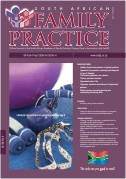Risk Factors Precipitating Exacerbations in Adult Asthma Patients presenting at Kalafong Hospital, Pretoria
Keywords:
asthma exacerbations, non-compliance, bacterial infections, triggers, risk factors
Abstract
Background: Research into asthma is proceeding at an unprecedented rate and yet we live with a disease that escalates in prevalence and severity, despite a greater understanding of its pathophysiology and the necessary therapy. The total prevalence of asthma is estimated to lie at 7.2% of the world’s population (6% in adults, 10% in children). Data from Australia, Canada and Spain report that acute asthma accounted for 1 to 12% of all adult emergency department visits. The prevalence of asthma in South Africa lies at 5% for adults and 10% for children. Asthma is reported as taking up 1 to 2% of the total health budget in direct costs, with equally large indirect costs being incurred for time lost from work and reduced productivity. It has also been reported that approximately one-third of the direct care costs of asthma are attributable to emergency department visits and hospitalisations. In some cases, exposure may be unavoidable (for example exposures to cold air, exercise or the asthma-inducing effects of pregnancy). Many studies have been done in other countries on specific triggers, especially allergens and viral respiratory infections. However, circumstances differ in the public sector in South Africa and other factors such as compliance and under-treatment, which may be applicable, should be studied in contention. Methods: A matched case-control study was undertaken matched on age and gender between December 2003 and May 2005. Known asthma patients with exacerbations presenting at Kalafong Hospital’s emergency unit were chosen as cases. Controls were stable asthma patients recruited from the outpatient departments. A structured questionnaire was used to interview patients concerning their possible exposure to certain triggers and risk factors. Univariate and multivariate analyses with conditional logistic regression were done to determine any significant exposures. Participants were between 18 and 65 years of age. Results: In total, 356 patients were evaluated. Fifty cases and 100 controls were enrolled. Cases were shown to be more non-compliant than controls (OR = 2.18; 95% Confidence interval (CI): 1.09 to 4.38, p = 0.03). Missing follow-up doctor’s appointments for the last six months were statistically significant with an OR of 2.39 (95% CI 1.08 to 5.27) and p = 0.03. Conclusions: Non-compliance was a strong predictor of exacerbations in adult asthma patients at Kalafong Hospital.
Published
2008-06-05
Section
Original Research
By submitting manuscripts to SAFP, authors of original articles are assigning copyright to the South African Academy of Family Physicians. Copyright of review articles are assigned to the Publisher, Medpharm Publications (Pty) Ltd, unless otherwise specified. Authors may use their own work after publication without written permission, provided they acknowledge the original source. Individuals and academic institutions may freely copy and distribute articles published in SAFP for educational and research purposes without obtaining permission.

